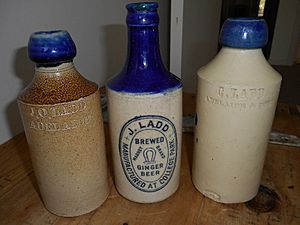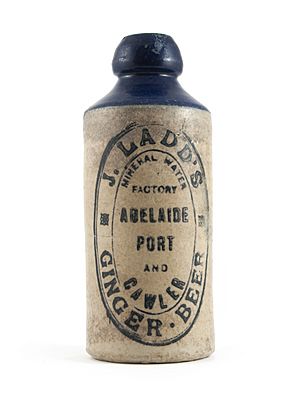Ladd's cordials facts for kids
Ladd's was a company in Adelaide, South Australia, that made soft drinks. It was a family business that operated for about 90 years, from around 1860 to 1950.
Contents
History of Ladd's Soft Drinks
The Beginning of Ladd's
Joseph Onesimus Ladd was born in England around 1818. He moved to Australia and arrived in Adelaide, South Australia, around 1847. In 1849, he received a special permit to run a hotel called the Gepp's Cross Hotel. Joseph married Caroline Fuller in 1853, and they had 13 children together.
Around 1860, Joseph Ladd started a business making ginger beer on Flinders Street, Adelaide. In 1868, he moved his business to a larger area on Rundle Street, Adelaide. The next year, he began making other types of cordials and fizzy drinks, also known as aerated waters.
Caroline Ladd Takes Over
Joseph Ladd passed away in 1882. His wife, Caroline Ladd, then took over the business. In 1884, she moved the factory to Harrow Road in College Park, South Australia. She made sure the new factory had the latest machines. The family also lived at this address.
Caroline chose this location because of the very pure spring water available there. Other famous drink companies, like Woodroofe's, Hall's soft drink factories, and Coopers Brewery, also used water from this area.
Ladd's Bottles Through the Years
Like other drink makers, Ladd's used many different kinds of bottles over the years.
- Some were "stonie" pottery bottles.
- Others were glass bottles, like the Codd pattern which had a glass ball inside to seal the drink.
- There were also Barrett or Riley pattern bottles, which had a special screw-top made of a hard rubber-like material called Vulcanite. These bottles held about 740 milliliters of drink.
- From around 1930, they started using crown seal bottles, which are common today.
The bottles always belonged to the drink company. If a bottle wasn't broken, it could be cleaned with steam and used again and again. Mrs. Ladd would buy used bottles from dealers. She told her workers to use all bottles, even if they had another company's name on them. This was against the rules of the workers' union at the time. The workers refused and threatened to strike. Mrs. Ladd wanted to use old bottles because they were much cheaper than buying new ones.
New Generations of Ladd's
Caroline Ladd passed away in 1897. Her son, Joseph Ladd (born 1856), then took over running the factory. Joseph had married Mary Cunningham in 1888. Their son, Roy Leslie Joseph Ladd (born 1892), married Jessie Ann Sutherland in 1917. They lived in Malvern, South Australia.
When Joseph Ladd died in 1929, his son Roy took over the business. Around this time, the company started using a horseshoe-shaped "Magnet" as their trademark.
In early 1948, the family business changed its structure to become a limited company. This means it became a type of company where the owners' responsibility for debts is limited. In June 1950, a new company called J. L. Aerated Waters Ltd. was created to take over Ladd's business. A month later, the new company was renamed "Ladds Limited."
Roy Ladd passed away in July 1954. Three months later, the company was closed down. The company's property in St Peters, South Australia and the right to use the trade name "Spa-Kup" were sold off.
See also



